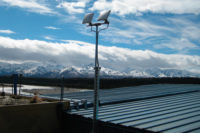
If you install video systems on a regular basis, you may think you know all you need to know about cable and wire. Think again. Between the variety of cable available, the types of installations it may be used for and various state and local codes, there’s a lot more to know than you may think.
Don’t believe that? Even an expert who has dealt with cabling for nearly 30 years and now provides training for installers and designers, can learn something new.
“I thought I knew cable after doing this for 29 years,” says Bryan McLane, vice president of Las Vegas-based National Training Center. “But after putting together four hours of training for a manufacturer, I realized I don’t know cable.”
Based on his personal experience, McLane suggests that every installer and designer, regardless of skill level and experience, could benefit from a little “Cable 101” training. That could be through an organization like NTC or through the many cable manufacturers who offer both online and instructor-led training.
Whether you opt to use fiber, Ethernet, coax or twisted pair, experts agree that the bottom line is you get what you pay for. The general rule of thumb is that the cheaper the cable, the lower the performance. Although price is a sensitive subject in today’s economy (for both installers and customers), price shouldn’t be the first consideration.
There are a number of issues you may run into with more cheaply made cable. For example, the jacket may be thinner, making it more prone to damage or abuse. The copper used for the wiring may not be as pure, which causes image quality to deteriorate more quickly the farther you get from the video source. David Engebretson, president of Chicago-based Slayton Solutions and a regular SDM columnist, says installers should be leery of cheaply made foreign cable. His recommendation is to stick with premium brands, preferably those that are made in the United States or Canada.
Which type of cable you use for a particular installation depends solely on the installation, and using the right wire for the right job is vital, says Bruce Repp, systems support representative for Melville, N.Y.-based ADI.
“Wire is the backbone of the system,” he states. “If it’s not the proper type or quality, it’s like cutting off your feet. When you’re looking at something that serves as a lifeline, price can’t dictate your decision.”
Rather than compare particular cable technologies against each other, here are some tips for selecting the highest-quality cable within each category:
• Fiber: Look for cable that uses glass fiber, rather than plastic. While glass is more delicate (and more expensive), the performance improvement over plastic fiber is worth the risk of damage and additional cost, McLane believes.
• Coaxial: The overwhelming majority of analog CCTV applications use coaxial cable. To ensure the highest quality performance, McLane recommends using a 95 percent copper braid or solid copper center cable rated at 75 Ohms. Anything less, he says, you’re asking for trouble. It’s also important to make sure you’re using a CCTV coax rather than one that’s made for use with cable TV; the two are not interchangeable.
• Ethernet: If you’re installing IP cameras, Ethernet is the way to go. While some would say you shouldn’t use a Cat6 cable on a Cat5 network, Eric Eisenbroek, systems support manager for ADI, thinks that’s not always the smartest move. In keeping with ADI’s policy, he encourages installers to use the highest level of technology available. That way, the system they’re installing is future-proof.
• Twisted pair: If using twisted pair for an analog camera, McLane’s main piece of advice is to go with an unshielded cable, which more effectively prevents electromagnetic interference.
All cables, regardless of type, must be tested for continuity, Engebretson says. In particular, fiber needs to be tested for light continuity. Because of the large number of factors that can cause damage — including forklifts, foot traffic and carelessness — this testing has to be done after the cable has been delivered to the job site to ensure it hasn’t been damaged in storage or transit.
Regardless of type, every cable includes some sort of solid conductor. Without proper care and handling, that solid conductor can be broken. Even worse, it can be damaged, meaning it may seem like it’s working after being installed, only to show signs of damage weeks, months or even years later.
Fiber optic cable is perhaps the most delicate because, at least in terms of the best quality fiber, its solid conductor is glass. But other types of cable can be damaged easily as well: solid copper cable can break, etc.
Temperature is another of cable’s archenemies, Eisenbroek says. With a few exceptions, most cables are not rated to withstand the extreme hot and cold they can experience while stored in a truck or van during summer or winter months. These extremes can change the cable’s characteristics, which deteriorates performance.
The potential for damage doesn’t end once you’ve tested the cable. Installation is also a large contributor to damage, Engebretson says. All cables have maximum pull strength ratings (for example, Cat5 Ethernet is rated to 25 pounds), so pulling or jerking cable too hard can cause a break. To avoid this, he recommends installers use cable lubricants to ease the pulling aspect of installation.
One final word of warning from Repp, who observed installers repeatedly stepping on Ethernet cable during an installation at ADI’s Chicago branch: Don’t leave cable lying on the ground. If you absolutely have to, make sure that no one steps on it.
Because it is such a necessary part of every installation, providers have accounted for bending in designing and manufacturing cable. However, manufacturers provide information on the maximum bend their cable is designed to withstand and still operate properly. Exceed those recommendations at your own risk.
Not surprisingly, typical bend calculations vary from cable type to cable type. For Ethernet, it’s four to five times the outer diameter of the cable. For coax, it’s also four to five. Fiber can be bent up to 20 times the outer diameter, while twisted pair is 10 times. Each manufacturer may have different standards, which is why most offer an online bend radius calculator.
As with care and handling, fiber is the most susceptible to damage from over-bending. Even though it’s flexible, at its core it’s still glass, which can develop micro-cracks that will dissipate signals. Worse yet, that dissipation may not be detectable immediately.
Different cables also come with different distance recommendations, which, like bend radius ratings, are provided by manufacturers. However, Engebretson says, there are two sets of standards for distance: formal standards and reality.
Formal standards are set by organizations like EIA and TIA, and provide the basis on which cable contractors work. Reality is a different story. If a cable is rated to 1,000 feet, some contractors will install it at 1,000 feet. Others will only go 750 feet to ensure a quality signal. Engebretson says the quality of cable over distance has a lot to do with the quality of the connectors. In other words, bad connectors mean bad connections. He says installers need to look at the specs for the system they’re installing and not exceed that maximum, even if they’re using high-quality cable and connectors.
Engebretson, McLane and Eisenbroek all advise installers to build in at least a 10 percent cushion when selecting wire to make sure not to exceed distance specifications.
So what are the maximum distance ratings for each type of cable? According to McLane, they are as follows: 30 miles for single mode fiber (two to five miles for multi-mode); 500 feet (safe distance) for coaxial; 328 feet for Ethernet; and 1,000 feet (manufacturer recommendation) or 750 feet (safe distance) for twisted pair.
In some cases, running power and video cables to the same camera can be a tricky proposition. However, as long as you stick to some basic guidelines, your installations should be fine.
You can run low-voltage power cables in the same pipe as signal, analog or Ethernet cables. The danger comes when you run signal cables in the same pipe or tray as high-voltage (110, 220 or 460 volts) cables. If you do so, in Engebretson’s words, “chaos will ensue.”
However, if you can’t possibly avoid running the two cables in the same conduit, Repp says to use fiber.
When it comes to choosing and installing cable, common sense rules the day. In addition to following the above advice, McLane says many installers don’t realize that local, state, NEC and NFPA codes apply to low-voltage installations as well as high voltage. Awareness of the codes will keep you out of trouble with inspectors and ensure that your installations are safe.
Another thing to consider, according to Eisenbroek and Repp, is termination of wires (for example, not terminating BNC properly or using the right Cat5 cap). Bad wire terminations are often to blame for transmission and quality problems, Eisenbroek reveals. He adds that environmental factors such as temperature and humidity can also have a negative effect on transmission clarity.
As for price, it can be a factor in deciding which cable to use, Eisenbroek says — but only after you’ve chosen the right wire for the job and identified a high-quality cable
Editor’s note: Security technicians and other industry professionals can get Cable 101 training, as referenced by Bryan McLane in this article, for free by contacting Contractors Wire & Cable at (800) 444-8816.
What Makes a Good Cable ‘Good’?
When choosing cable, there are specific factors to look for in order to ensure the highest quality.
• Fiber: Glass fiber, rather than plastic.
• Coaxial: 95 percent copper braid or copper center, rated at 75 Ohms. Never use RG6 cable, which is less expensive but is normally used in cable TV installations.
• Ethernet: Cat6 cable ensures the system is future-proof.
• Unshielded cable significantly reduces electromagnetic interference.
With all of these cable types, make sure the cable has been certified by UL or another reputable listing agency.
Cable Footage Markers
It’s usually the little innovations that make our work easier. For as long as I can remember, we have had rip-cords to remove a cable’s jacket, wire strippers to remove the insulation and an assortment of punch-down and crimping tools with which to install connectors. However, descending length markers on the jacket from 1,000 feet down to zero feet is a relatively recent innovation having taken root in the last decade.
As a security dealer you probably remember, not so fondly, one or more experiences where you were installing cable without footage markers. You may have been pulling cable in an oppressively hot attic during the summer or in a drafty and cold crawl space during the winter. In both cases you lifted up the pull-boxes of cable that you had and chose the one that felt heaviest to ensure that you had enough cable for the run.
However, when you were in the far end of the attic or crawl-space, you suddenly found that the cable was pulling much easier out of the box because you had just run out of cable. Thus, you would have had to repeat the aborted process after you had an opportunity to purchase a new box of cable from your distributor.
Descending footage markers on the cable always tell you accurately how much cable is left in the box and this prevents 99 percent of field installation problems. Always check that the cables that you buy have footage markers on the jacket. — Contributed by Randy Hall, president, Contractor’s Wire & Cable
Lesson Learned — and Paid for
Ensuring that the cable you’ve chosen for a job is not only high-quality, but also the right fit for the job is critical, says NTC’s Bryan McLane. To illustrate the point, he related the story of how a lack of cable knowledge came back to bite an installer once the job had been completed.
About a month after installing a video system at a car dealership, the installer called McLane for help with determining why the dealership was getting either a weak signal or no signal at all from its cameras. The first thing McLane asked was what type of cable had been used.
As it turned out, the installer had used RG6 aluminum braid coaxial cable, which works well for cable TV, but not so well for video transmission. McLane’s advice? Pull out all of the cable and install coax with a copper-braid center.
That would be a problem, the installer told him, because the cable had been buried and then paved over as part of the dealership’s parking lot. In the end, the pavement had to be torn up, the cable trenched out and new cable installed — a very expensive lesson learned.


